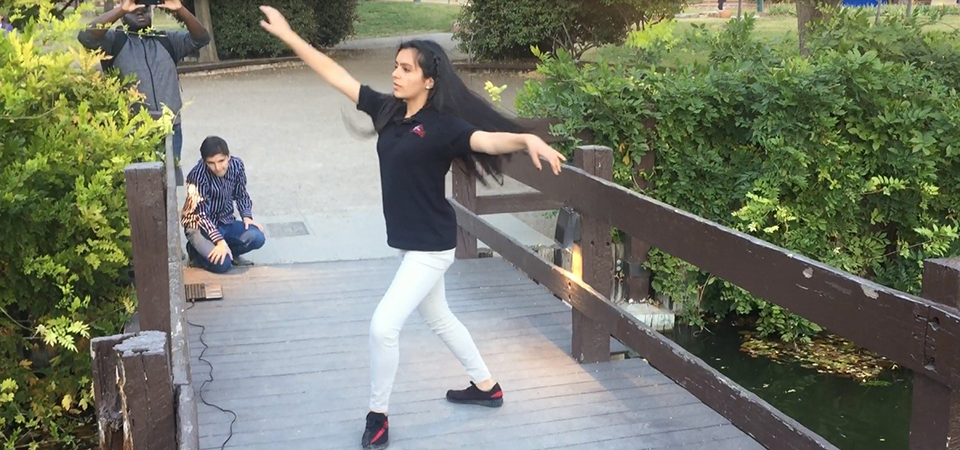Dancer, researchers collaborate to expand connection between arts and engineering
 Dancing and engineering seem worlds apart, one artsy, the other all about math and technology. But a research group of computer engineering students housed at the University of New Mexico Center for Advanced Research Computing has collaborated with a local dancer to improve her performance while learning more about the possibilities of their own work.
Dancing and engineering seem worlds apart, one artsy, the other all about math and technology. But a research group of computer engineering students housed at the University of New Mexico Center for Advanced Research Computing has collaborated with a local dancer to improve her performance while learning more about the possibilities of their own work.
“Dancing and engineering are really far apart but by finding that connection, dancers are exploring an area they are curious about now that they didn’t know about before,” observed Professor Fernando Moreu. “They are interested in technology and interested in using technology to inform their dancing quality.”
Moreu is an assistant professor of civil engineering at UNM and has a courtesy appointment in electrical and computer engineering. He is the director of SMILab, Smart Management of Infrastructure Laboratory, a research group aiming to develop the use of next-generation smart sensing technologies, including wireless sensors, and general human-machine interfaces.
The dancer collaborating with the group is Selene Diaz of Argentina, who graduated in May 2018 from Menaul High School. She came to Albuquerque as an international student and has been dancing since she was a small child.
Diaz’s mentor at Menaul High School recommended she work with Moreu and his group for her senior project. She visited the engineering department open house last fall and decided to do a project to relate technology to her dancing.
“She would like to learn about her dancing using data that she could quantify with technology. Usually she would look at mirrors, other dancers, get feedback from her teachers and peers, and repeat the steps. Human judgment is still needed,” Moreu explained.
Using technology to track dancing has typically been intrusive and expensive, he said. It involves wearing a number of sensors that are then tracked by experts as the dancer moves in a laboratory.
“They are basically guinea pigs. But here, the dancer is the inventor. It’s collaborative,” he said.
Diaz and the group set out to develop low-cost sensing technology to acquire, analyze, and interpret data to characterize dance steps, use statistical theory to assess quantitative features of various dance steps such as a jeté and assemblé, and enable a dancing-centered monitoring solution that dancers can use in collaboration with engineers.
She met with the group weekly. Members of the group were mechanical engineering student Emmanuel Ayorinde; Civil, Construction, and Environmental Engineering Department (CCEE) graduate students Dilendra Maharjan and Marlon Aguero, Dr Ali Ozdagli, a post-doctoral fellow at CCEE; and Ronny Moreano, a visiting scholar from Ecuador.
Diaz hypothesized that the surface would vibrate differently with various moves and levels of expertise. The group helped her learn the skills to build a sensor that would analyze vibrations and generate data as she danced. They filmed and monitored data as Diaz danced at the UNM duck pond bridge.
(Watch a video of Diaz building the sensor.)
She used the experience and data to make a presentation called “Dancing and Engineering: real-time visualization of data for dancers’ performance” at the Engineering Mechanics Institute meeting last summer at the famed Massachusetts Institute of Technology, the only high school student to do so. Diaz so highly impressed the researchers at the conference with her presentation that an attendee mistook her for a graduate student or assistant professor.
Diaz isn’t the only person using the information the group has compiled. Maharjan is studying signal post-processing engineering, structural dynamics theory, and systems modeling, and writing a journal paper about their experiments and collaboration. The other collaborators are learning to think outside the box, Moreu said. “Dilendra and Selene met at MIT with the leaders in structural dynamics and human-machine, human-structures interaction, and collected innovative ideas for their future research.”
“This (dance) is a non-territory for engineers,” he said. “All of a sudden use of sensors is in unknown territory. But they’re more curious now and thinking outside of the conventional classroom environment and outside their discipline. My grad students benefit from this too. Our summer intern Elijah Wickoff wants to become a leader in sports engineering, advancing the human-structure interaction using our sensors, or a new version of these sensors he will build here at CARC. Ricardo Fernandez, another SMILab intern, is helping us and Los Alamos National Laboratory developing Augmented Reality hardware and software combined. The more we dive into human-machine interfaces, the more interesting engineering gets for all of us.”
